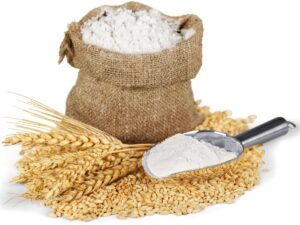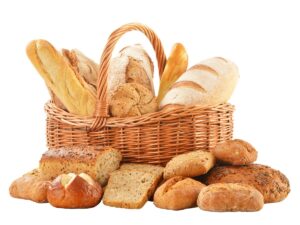By Kathryn Cole, MS, RD
How many of you remember learning about the food pyramid as a kid? Is its suggestion of consuming 6-11 servings of grains daily, still etched in your memory? Not only is this nutritional guidance outdated, but following this advice may pose significant risks to your well-being! Although these recommendations have been revised several times, the official government recommendation still involves a significant amount of grains. The newest version of My Plate suggests a lesser amount of grains (up to 8 ounces), with the majority of those from whole grains. However, judging from portion sizes in restaurants and feedback from our Nutrition consults, it seems most Americans are consuming much more than the recommended amount. Grain-based foods are the number one source of calories in American diet. This includes bread, rice, pasta, cakes, cookies, and pastries, etc. We now know that most grains are far from a “health food.” Marketing may deceive us with the attractive claims of “whole grain” on the front label, but let’s not be fooled!
The Carbohydrate Controversy
Carbohydrates have become a hot topic of controversy lately, yet numerous foods fall under this category. It may surprise you to know that vegetables are technically carbohydrates! Carbs can be found in vegetables, fruits, grains, legumes, and even nuts. While many of these foods offer health benefits, it’s important to note there are no “essential” carbohydrates. Unlike essential fatty acids (fundamental to fat) and essential amino acids (building blocks of protein), there are no carbohydrates deemed essential. This means we do not HAVE to eat carbohydrates. The body can actually make the glucose it needs from other sources.
The average American consumes 132 lbs. of flour per year – that’s about 1/3 lb. per day! Between the breakfast cereal, a sandwich for lunch, and pasta with bread for dinner, it adds up quickly! You might be wondering, “Is whole wheat flour a better option than white flour?” Whereas whole wheat flour boasts higher fiber content, it remains comparable to white in calories and glycemic index. And surprisingly, whole wheat even surpasses table sugar in terms of glycemic index! This implies that consuming two slices of wheat bread could elevate your blood sugar higher and longer than a tablespoon of sugar.

But People Have Always Consumed Grain
Many pose the argument “but people in biblical times consumed bread.” Well, there’s a big difference between biblical wheat and the wheat we have today. Back then, it was notably high in protein, low in gluten, and free from glyphosate. Because of hybridization over the years, our grains now contain substantial levels of amylopectin, constituting around 80% of starch molecules. This compound rapidly raises blood sugar and insulin, posing concerns for heightened abdominal fat and insulin resistance.
Let’s delve into gluten. Over the last 50 years, Celiac disease (a gluten allergy) has seen a staggering 400% increase. Beyond those with Celiac disease, around 20% of the population experiences gluten sensitivity – digestive symptoms even without measurable intestinal damage. Even without a gluten sensitivity, it’s worth noting that wheat shouldn’t be a daily dietary staple.
Gluten triggers the production of Zonulin, a compound that regulates activity of the tight junctions in the intestinal lining. Some amount of Zonulin is necessary, but when in excess it heightens the gut lining’s permeability. This is called “leaky gut”. The gaps allow large undigested proteins out into circulation, and can potentially lead to allergies and inflammatory conditions over time.
Did you know that the intestinal lining is very similar to the blood-brain barrier? And so damage to one tissue can easily correlate to damage in the other. Gluten can act as a neurotoxin affecting the blood-brain barrier and the way one thinks, affecting neurotransmitter production and altering the microbiome of the gut and brain.

Autoimmunity and Chronic Disease Linked to Grain
Unfortunately, autoimmune conditions are massively on the rise in the U.S., especially Hashimoto’s, Graves’, Multiple Sclerosis, and Lupus. This is a multi-factorial problem, and there is no one particular cause. Many triggers could be involved, including pesticides, fragrances, parabens, phthalates, other chemicals, and most of all – stress. But at this point, it’s undeniable that gluten is a major cause of autoimmunity, too. We know this (anecdotally) because many conditions start getting better once gluten is removed from the diet.
In many cases, gluten sensitivity contributes to:
- Asthma – One of the first signs of asthma was actually in bakers who were regularly inhaling wheat flour. Asthma rates are high in children partly because their diets are high in bread, pasta, and cereals.
- Hypothyroidism – a condition marked by low metabolism and foggy brain function, which is better controlled by a gluten-free diet.
- Eczema – a widespread skin condition among children, which responds extremely well to a gluten-free diet.
- ADD or ADHD – the inability to focus and concentrate can be described as a chronic low level of inflammation in the brain and/or blood-brain barrier.
- Schizophrenia – symptoms improve dramatically with the elimination of gluten.
- Psoriasis, Psoriatic Arthritis, Neuropathy, and Migraines – all show improvement when implementing a gluten-free diet.
While gluten may not be the sole cause of a condition, for anyone with one or more of these issues, it is worth eliminating to see if symptoms improve.

Gluten-Free Is Not Necessarily Healthy
It’s crucial to recognize that just because something is gluten-free doesn’t automatically make it a healthy choice – for instance, Coca-Cola is gluten-free, but we’re well aware that it’s not a healthy option!
When you think about going gluten-free, you want to think about foods that naturally don’t contain gluten. Opting for gluten-free bread or wraps made with potato starch or tapioca starch – plus gums and thickeners – is not necessarily good for your health. These packaged items often have a high glycemic load and lots of added sugar. As such, they are not very satisfying, and wreck your blood sugar (and cravings), too.
Fresh fruit and vegetables, meat, poultry, fish, cheese and eggs are naturally gluten-free, so use these as the foundation of your meals. Also, popular gluten-free grains and starches like quinoa, rice, buckwheat, and millet can easily take the place of your typical breads and crackers. And small amounts of grain-free alternatives such as almond flour, coconut flour and cassava flour can be part of a healthy, anti-inflammatory diet. The key is small amounts.
And a helpful hint for those who love rice: cook your rice ahead of time, allow it to cool overnight in the fridge and then reheat it to create resistant starch. These are starch molecules that resist digestion, functioning like fiber in the body to improve digestion, feed good bacteria in the gut and lower blood sugar.

Benefits of a Grain-Free Diet
To summarize, the one food we should all try to eliminate is white or wheat flour, as these raise our blood sugar, insulin, and potentially damage our gut. With one in two Americans now having diabetes or prediabetes, managing blood sugar should be a top priority for everyone!
With a focus on non-gluten foods, you’ll naturally consume more colorful fruits and vegetables, salads, meat, eggs, nuts, and seeds. The increase in phytochemicals and good nutrition are sure to improve your health.
Remember with this easy change in diet, you have nothing to lose and everything to gain!
Need some help figuring out how to make these changes? Contact us for a Nutrition consult and Meal Planning Services. We’d love to help you get better!


